Lithuanian transmission system
Amber Grid, the Lithuanian gas transmission system operator, is responsible for the safe and reliable transmission of natural gas through high-pressure pipelines. The company operates a 2,288 km long network of high-pressure gas pipelines throughout Lithuania and manages 68 gas distribution and metering stations and two gas compressor stations.
Structure of our gas transmission system:
The Amber Grid system is interconnected with the gas transmission systems of four countries: Latvia, Belarus, Poland and Russia’s Kaliningrad Oblast, the Klaipėda liquefied natural gas (LNG) terminal, and the systems of Lithuanian gas distribution operators.
Lithuania’s well-developed gas transmission system serves as a regional corridor for the transmission of gas northwards to Latvia and southwards to Poland.
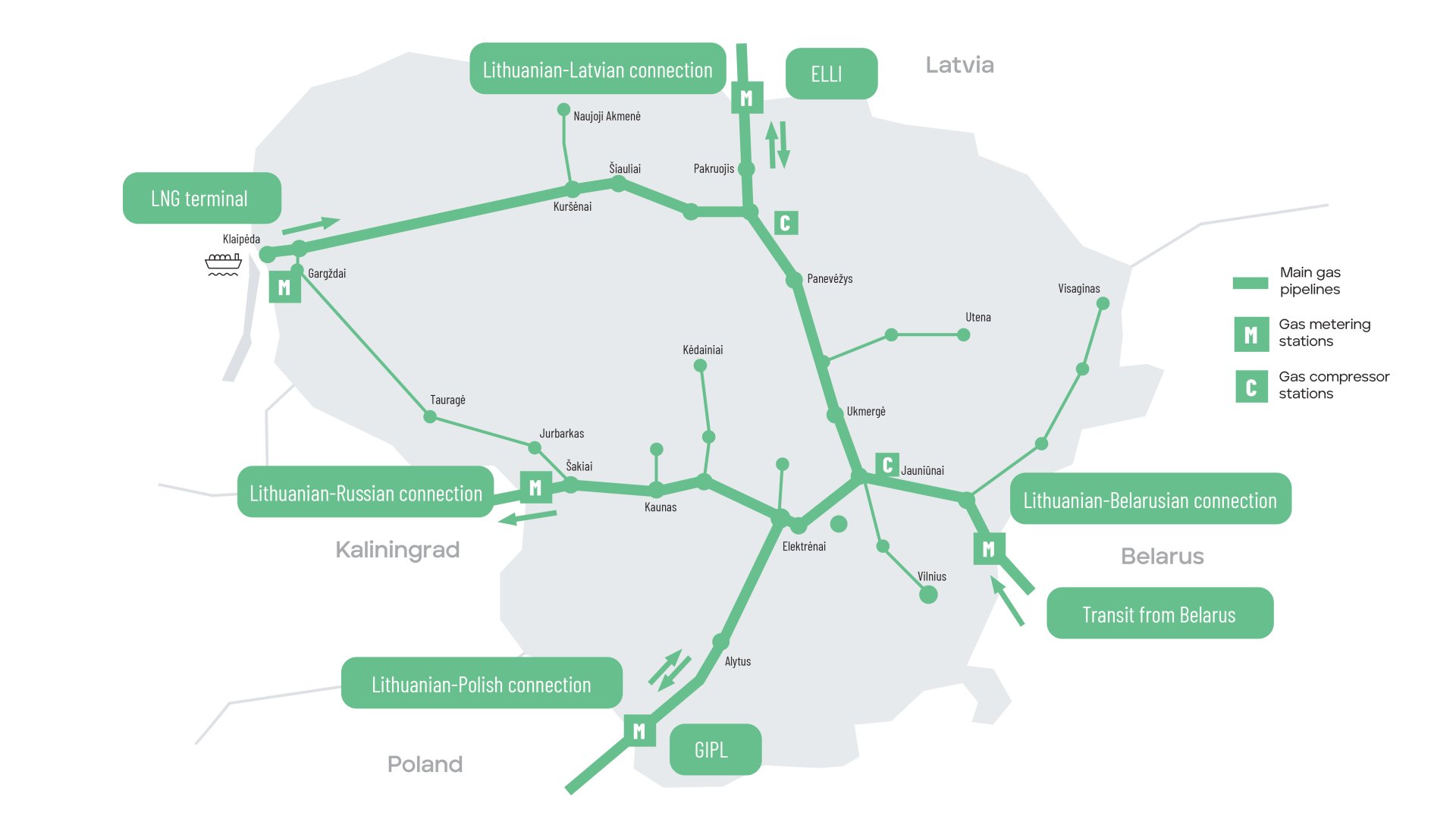
Main Components of the Transmission System
The network of main gas pipelines in Lithuania started to be developed in 1961. The most commonly used pipelines have a diameter of 700 mm, while the maximum diameter of the gas pipelines in the Lithuanian network is 1220 mm. Most of the transmission system has a design pressure of 54 bar. With the installation of the Klaipėda LNG terminal in Lithuania, most of the gas for the needs of Lithuania and the Baltic States comes through it.
The main purpose of gas compressor stations is to increase the pressure of the gas and to create more capacity so that large volumes of gas can be transported as far as possible. Gas compressor stations are normally installed every few hundred kilometres.
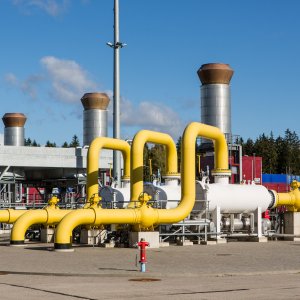 The Jauniūnai GCS was installed in 2010. It compresses natural gas and raises the pressure in the main gas pipeline to 54 bar. Three gas turbines with centrifugal gas compressors are operated at the station. The total capacity of the station is 34.5 MW.
The Jauniūnai GCS was installed in 2010. It compresses natural gas and raises the pressure in the main gas pipeline to 54 bar. Three gas turbines with centrifugal gas compressors are operated at the station. The total capacity of the station is 34.5 MW.
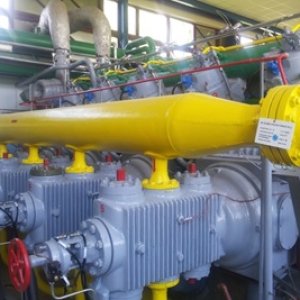 The Panevėžys GCS was installed in 1974 to transport natural gas in the directions of Riga, Klaipėda, and Vilnius. The station is also reversible as it is possible to reverse the direction of the gas. The seven reciprocating compressors at the station have a total capacity of 7.7 MW.
The Panevėžys GCS was installed in 1974 to transport natural gas in the directions of Riga, Klaipėda, and Vilnius. The station is also reversible as it is possible to reverse the direction of the gas. The seven reciprocating compressors at the station have a total capacity of 7.7 MW.
The gas metering station is equipped with gas quality and metering equipment to determine the quantity and quality of gas entering and exiting the system.
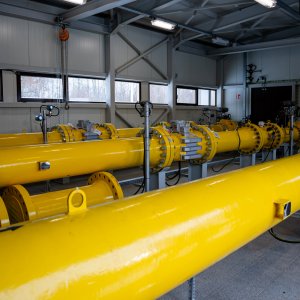 The Kiemėnai GMS was built in 2005 to improve the reliability of natural gas supply. It allows us to use Latvia’s Inčukalns underground natural gas storage facility, which is owned by the Latvian gas transmission system operator Conexus Baltic Grid. The metering station is a reversible metering station, so gas supplied in both directions is metered. The station is designed to operate in automatic mode. Its capacity from Lithuania to Latvia is 270,000 nm3/h, and 260,000 nm3/h from Latvia to Lithuania. The strategic ELLI project will be completed by the end of 2023 and the capacity from Lithuania to Latvia is planned to be increased to 448,000 nm3/h, and to 443,000 nm3/h in the opposite direction.
The Kiemėnai GMS was built in 2005 to improve the reliability of natural gas supply. It allows us to use Latvia’s Inčukalns underground natural gas storage facility, which is owned by the Latvian gas transmission system operator Conexus Baltic Grid. The metering station is a reversible metering station, so gas supplied in both directions is metered. The station is designed to operate in automatic mode. Its capacity from Lithuania to Latvia is 270,000 nm3/h, and 260,000 nm3/h from Latvia to Lithuania. The strategic ELLI project will be completed by the end of 2023 and the capacity from Lithuania to Latvia is planned to be increased to 448,000 nm3/h, and to 443,000 nm3/h in the opposite direction.
The Šakiai GMS, built in 1994 on the border with Russia’s Kaliningrad Oblast, was reconstructed in 2009. Its capacity amounts to 480,000 nm3/h. The Kotlovka gas metering station on the Lithuanian-Belarusian border meters gas in transit, which is transported through Lithuania and transferred to the Kaliningrad system via the Šakiai GMS.
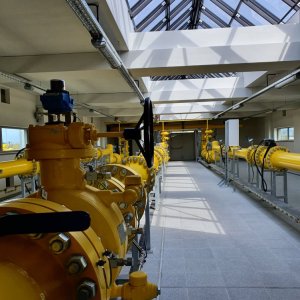 Following the completion of the GIPL strategic gas interconnection project between Lithuania and Poland in 2021, the Santaka gas metering and pressure regulation station (GMRS) was installed in Lazdijai District. The Santaka station has become the gateway to Europe for Lithuania’s gas transmission system. Gas transferred to the station by European suppliers is metered and checked and the pressure is adjusted to meet the needs of the system. Similarly, gas from Lithuania is transferred to Poland and other European countries via this station.
Following the completion of the GIPL strategic gas interconnection project between Lithuania and Poland in 2021, the Santaka gas metering and pressure regulation station (GMRS) was installed in Lazdijai District. The Santaka station has become the gateway to Europe for Lithuania’s gas transmission system. Gas transferred to the station by European suppliers is metered and checked and the pressure is adjusted to meet the needs of the system. Similarly, gas from Lithuania is transferred to Poland and other European countries via this station.
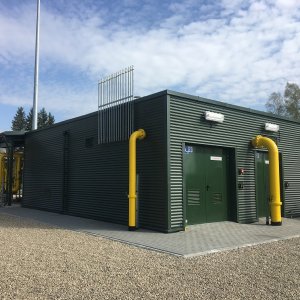 There are 64 gas distribution stations in Lithuania. Their main purpose is to reduce the pressure of the gas coming from the main gas pipelines to a pressure suitable for the gas distribution network; the gas is given a specific smell.
There are 64 gas distribution stations in Lithuania. Their main purpose is to reduce the pressure of the gas coming from the main gas pipelines to a pressure suitable for the gas distribution network; the gas is given a specific smell.
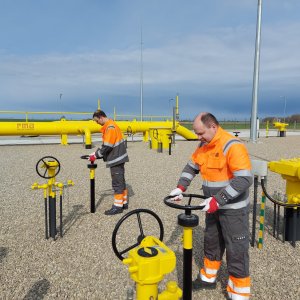 Scheduled repairs and maintenance work are being carried out to ensure the reliability, efficiency, and safety of the main gas pipelines. Depending on the characteristics of the pipeline, the technological layout, and the results of the maintenance, additional attention is paid to the highest-risk main gas pipelines. Periodic pipeline inspections or internal diagnostics are carried out. Currently, 1833 km of pipelines are suitable for internal diagnostics. By 2024, 80% of main gas pipelines are expected to be adjusted.
Scheduled repairs and maintenance work are being carried out to ensure the reliability, efficiency, and safety of the main gas pipelines. Depending on the characteristics of the pipeline, the technological layout, and the results of the maintenance, additional attention is paid to the highest-risk main gas pipelines. Periodic pipeline inspections or internal diagnostics are carried out. Currently, 1833 km of pipelines are suitable for internal diagnostics. By 2024, 80% of main gas pipelines are expected to be adjusted.